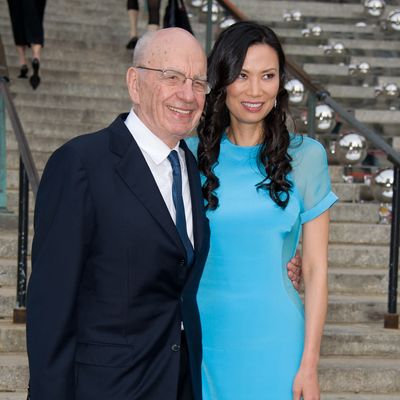Photo: Gilbert Carrasquillo/2011 Gilbert Carrasquillo
If you happened to pick up the Times Sunday “Styles” section this weekend, perhaps you noticed that the framing of the long profile of Wendi Murdoch felt a little familiar. We learned that Murdoch “has emerged with her own independent career.” She is, it continues, “a world-class networker, collecting powerful friends and brokering connections. She hosts annual dinner parties with powerful women, hosts book parties for friends, and regularly holds get-togethers.” How did she come by this newfound reputation?
“Until the cream-pie incident, she’d really been branded the classic younger wife with a tinge of racism and stereotyping,” said Andrew Butcher, a former senior communications executive at News Corporation. “That turned everything around for her.”
“It seemed to finally give the marriage legitimacy,” he added.
In short, Wendi Murdoch — beautiful, social, and far younger than her powerful husband — is not a trophy wife, we are meant to understand, and all it took was a little cream pie to get us to notice. And yet the whole rehashing of the ways she’d been tagged one by other people seems a subtly undermining way of going about pointing that out.
If that framing did indeed seem less than fresh, maybe you read the “Style” section’s April profile of Cassandra Huysentruyt Grey, the “pretty young second wife” of Paramount Pictures’ CEO, who, we were cautioned, should not be underestimated because of her youth and good looks.
But don’t call her a trophy wife. Mrs. Grey may have a Lilliputian figure, but she has big ambitions for a fashion studio and vintage clothing line that she runs from this town’s trendy shopping district.
How big? Asked that question the other day, she picked up a copy of Salvador Dali’s 1942 autobiography, “The Secret Life of Salvador Dali,” and pointed to a passage: “At the age of six I wanted to be a cook. At seven I wanted to be Napoleon. And my ambition has been growing steadily ever since.”
Because trophy wives never open vanity fashion lines, you see. Nor do they get involved in projects like this one:
In December, Italian Vogue posted on its Web site an over-the-top video profile of Mrs. Grey. It began with text reading “Meet the Princess of Bel-Air” and depicted her as a self-involved one-percenter riding in a chauffeured sedan and fixated on what to wear while walking the dog.
“I’m taking my role as a wife and a lover and a stepmother very seriously, meaning I want to be really, really good at it,” she said to the camera, sitting on a bathroom counter in a short robe and smoking a cigarette in a Marlene Dietrich pose, her makeup heavy and her head wrapped in a red scarf.
Or then there’s the recent profile of Trudie Styler, or, as the Times headline declared, “More Than Mrs. Sting,” a romp through Styler’s socialite life and presidential ogling, that ends on a wistful little note meant, it seems, again, to undermine the whole premise of the article.
From time to time, Ms. Styler has been asked to imagine what her life would have been had she not married Sting. “I have no idea,” she said, then added after a beat, “For sure, I would have had a life in which I would be in the driving seat.”
The paper’s refusal to profile decorative wives of the rich and famous without nodding at their brain power and ambition might date back to 1995, when the paper of record declared that among the rich, “the days of the old-fashioned trophy wife — long on glamour, short on resume — are on the wane.” But is that actually the old-fashioned definition?
Consider a 2007 profile of Fred Thompson’s then-40-year-old wife Jeri Kehn Thompson, whose “youthfulness, permanent tan and bleached blond hair” were described alongside this rather bald question: “Is America ready for a president with a trophy wife?” The piece (“Will Her Face Determine His Fortune?” as if his hot wife were the main problem with Thompson’s candidacy) explained: “Although it often has a pejorative spin, the term originally meant the second (or third) wife of a corporate titan, who was younger, beautiful and — equally important — accomplished in her own right, which describes Mrs. Thompson.” The paper, at least there, wants us to return to a different, original (kinder?) meaning of trophy wife — one that, in the more recent profiles of not-trophy-wives Murdoch and Huysentruyt, seems to have been reimagined once again.
The “Style” section, after all, needs to be able to have it both ways to pull in readers for profiles like these — gossipy fun that has at least a facade of seriousness. After all, even an old, powerful paper like the Times isn’t above trotting out a few fluffy, superficially attractive pages a couple times a week. But don’t call it a trophy section.
Who Qualifies As a Trophy Wife These Days?






























